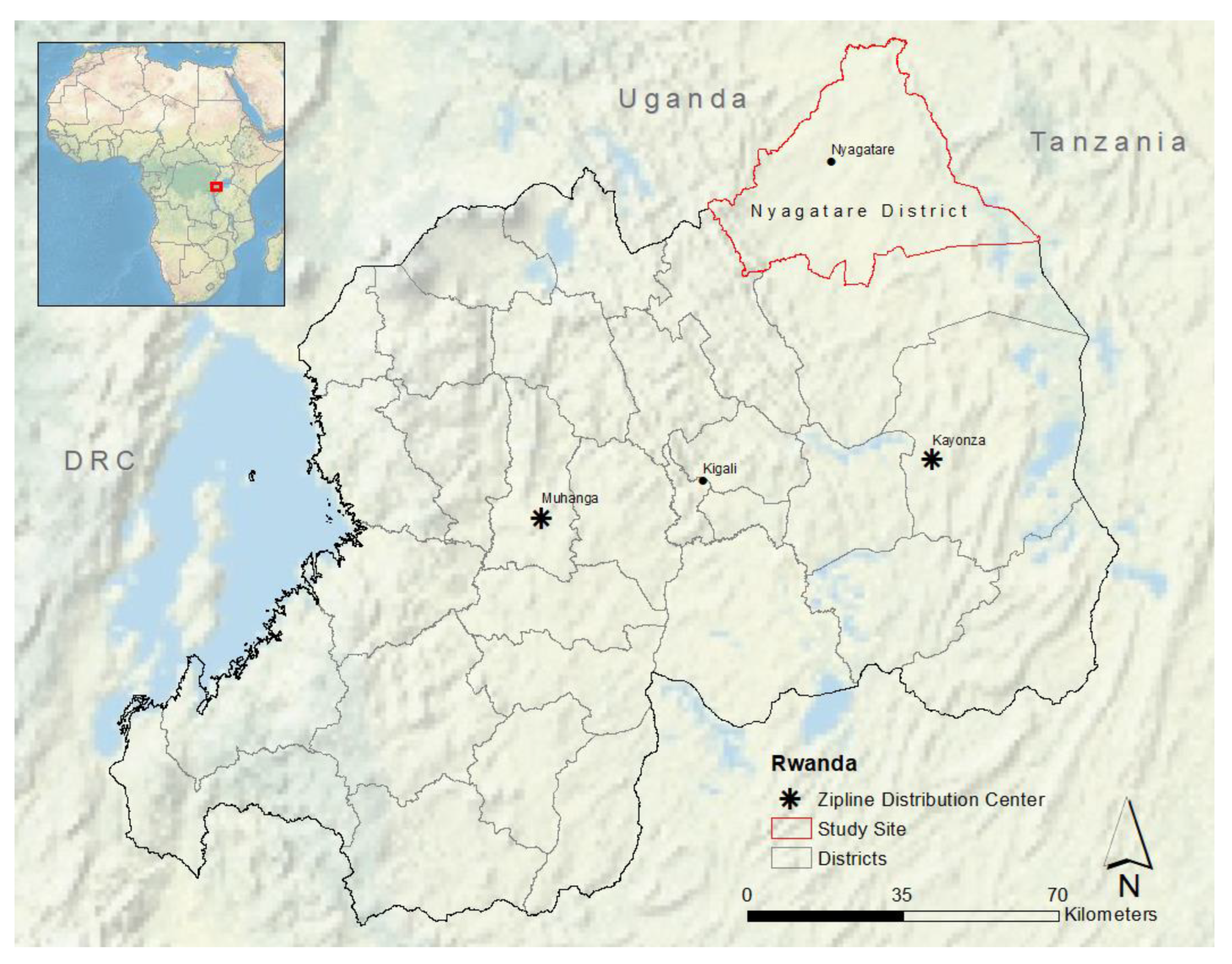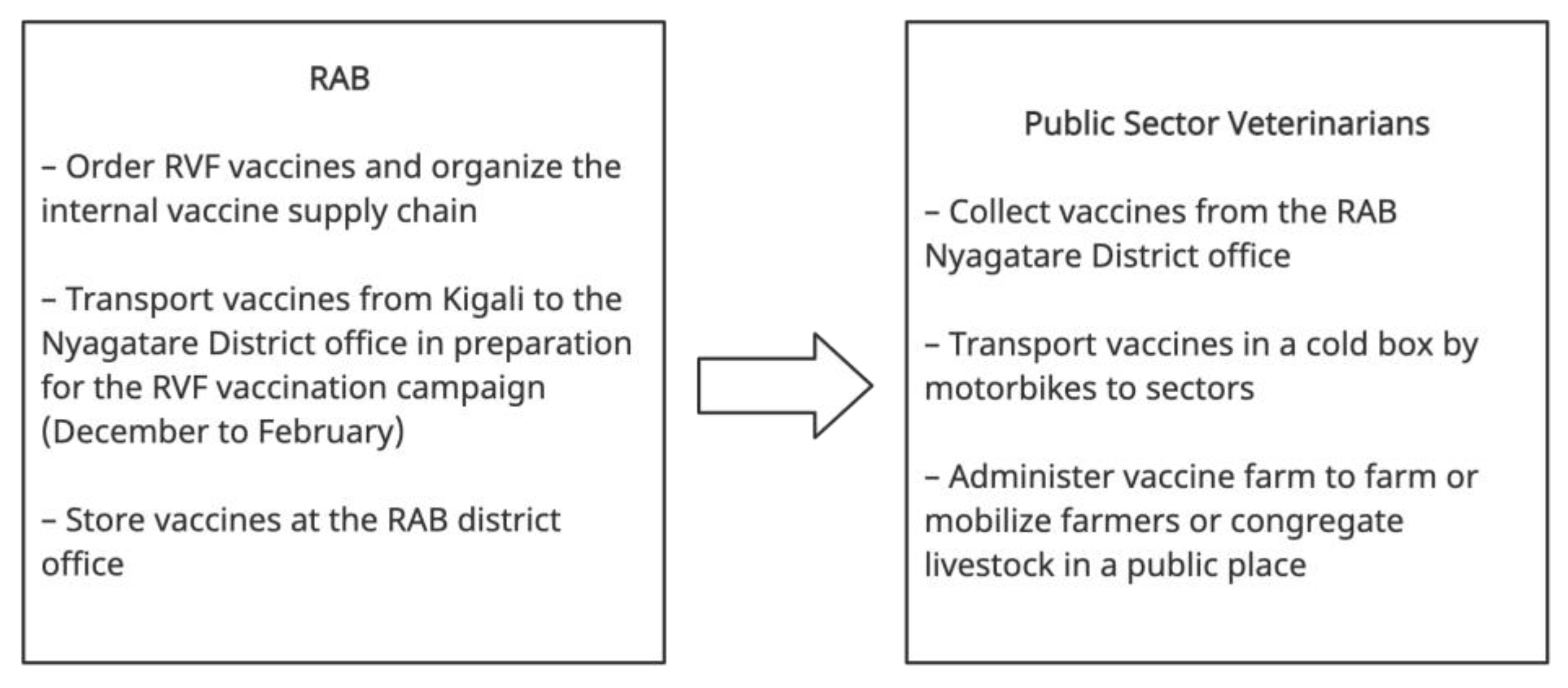The Use of Drones to Deliver Rift Valley Fever Vaccines in Rwanda: Perceptions and Recommendations
Abstract
1. Introduction
2. Materials and Methods
2.1. Study Area
2.2. Sampling and Data Collection
2.3. Data Analysis
2.4. Ethical Approval
3. Results
3.1. Animal Health Sector
3.1.1. Knowledge of Rift Valley Fever
3.1.2. Current Vaccination Protocols
3.1.3. Logistical Constraints
3.1.4. Recommendations for Improving RVF Vaccination
3.1.5. Perceptions of Drone Use
3.1.6. Challenges of Drone Implementation
3.1.7. Other Diseases
3.2. Zipline
3.2.1. Operation
3.2.2. Benefits of Drone Use in the Animal Health Sector
3.2.3. Challenges of Expansion into the Animal Health Sector
3.2.4. Suggestions for Implementation
4. Discussion
5. Conclusions
Supplementary Materials
Author Contributions
Funding
Institutional Review Board Statement
Informed Consent Statement
Data Availability Statement
Acknowledgments
Conflicts of Interest
References
- Overseas Advisory Council. Health Alert: Kigali (Rwanda), Rift Valley Fever Outbreak in East Province. 2018. Available online: https://www.osac.gov/Content/Report/a28b4829-7a91-4908-9c85-15f4ae72fd19 (accessed on 21 December 2022).
- Smith, L.J.; Schurer, J.M.; Ntakiyisumba, E.; Shyaka, A.; Amuguni, J.H. Rift Valley fever knowledge, mitigation strategies and communication preferences among male and female livestock farmers in Eastern Province, Rwanda. PLoS Negl. Trop. Dis. 2021, 15, e0009705. [Google Scholar] [CrossRef] [PubMed]
- OIE World Animal Health Information System. Rwanda: Rift Valley Fever Virs (Inf. with). 2022. Animal disease event search for RVF in Rwanda. Available online: woah.org (accessed on 21 December 2022).
- Ngabonziza, D. Rwanda Declaries Quarantine as Deadly Rift Valley Fever Claims 99 Cattle. 2018. Available online: https://www.ktpress.rw/2018/06/rwanda-declares-quarantine-as-deadly-rift-valley-fever-claims-99-cattle/ (accessed on 21 December 2022).
- Hartman, A. Rift Valley Fever. Clin. Lab. Med. 2017, 37, 285–301. [Google Scholar] [CrossRef] [PubMed]
- Uwishema, O.; Chalhoub, E.; Torbati, T.; David, S.C.; Khoury, C.; Ribeiro, L.L.; Nasrallah, Y.; Bekele, B.K.; Onyeaka, H. Rift Valley fever during the COVID-19 pandemic in Africa: A double burden for Africa’s healthcare system. Health Sci. Rep. 2022, 5, e468. [Google Scholar] [CrossRef] [PubMed]
- Mohamed, M.; Bloland, P.; Paweska, J.; Omulo, S.; Zeidner, N.; Njenga, M.K.; Shieh, W.-J.; Zaki, S.R.; Mmbuji, P.; Mosha, F.; et al. Epidemiologic and Clinical Aspects of a Rift Valley Fever Outbreak in Humans in Tanzania, 2007. Am. J. Trop. Med. Hyg. 2010, 83, 22–27. [Google Scholar] [CrossRef]
- Rich, K.M.; Wanyoike, F. An Assessment of the Regional and National Socio-Economic Impacts of the 2007 Rift Valley Fever Outbreak in Kenya. Am. J. Trop. Med. Hyg. 2010, 83, 52–57. [Google Scholar] [CrossRef]
- Faburay, B.; LaBeaud, A.D.; McVey, D.S.; Wilson, W.C.; Richt, J.A. Current Status of Rift Valley Fever Vaccine Development. Vaccines 2017, 5, 29. [Google Scholar] [CrossRef]
- Mariner, J.C.; House, J.A.; Mebus, C.A.; Sollod, A.E.; Chibeu, D.; Jones, B.A.; Roeder, P.L.; Admassu, B.; Klooster, G.G.M.V. Rinderpest Eradication: Appropriate Technology and Social Innovations. Science 2012, 337, 1309–1312. [Google Scholar] [CrossRef]
- Gitonga, P.; Gachene, C.K.; Njoroge, E.; Thumbi, S.M. Small ruminant husbandry practices amongst Kajiado and Marsabit pastoralists and their effects on Peste des petits ruminants control strategies. Development 2016, 28, 2. [Google Scholar]
- Kiara, H.; Munene, A.; Omondi, I.; Wako, D.D.; Takal, S.O.; Bett, B.; Wamwere-Njoroge, G.J. Delivery of animal health services in extensive livestock systems in Kenya. In Proceedings of the Seventh All Africa Conference on Animal Agriculture, Accra, Ghana, 29 July–2 August 2019. [Google Scholar]
- Alders, R.; Bagnol, B.; Young, M.P.; Ahlers, C.; Brum, E.; Rushton, J. Challenges and constraints to vaccination in developing countries. Dev. Biol. 2007, 130, 73–82. [Google Scholar]
- Acosta, D.; Hendrickx, S.; McKune, S. The livestock vaccine supply chain: Why it matters and how it can help eradicate peste des petits Ruminants, based on findings in Karamoja, Uganda. Vaccine 2019, 37, 6285–6290. [Google Scholar] [CrossRef]
- Jaime, G.; Hobeika, A.; Figuié, M. Access to veterinary drugs in sub-saharan Africa: Roadblocks and current solutions. Front. Vet. Sci. 2022, 8, 1612. [Google Scholar] [CrossRef]
- Haidari, L.A.; Brown, S.T.; Ferguson, M.; Bancroft, E.; Spiker, M.; Wilcox, A.; Ambikapathi, R.; Sampath, V.; Connor, D.L.; Lee, B.Y. The economic and operational value of using drones to transport vaccines. Vaccine 2016, 34, 4062–4067. [Google Scholar] [CrossRef] [PubMed]
- Gunaratne, K.; Thibbotuwawa, A.; Vasegaard, A.E.; Nielsen, P.; Perera, H.N. Unmanned Aerial Vehicle Adaptation to Facilitate Healthcare Supply Chains in Low-Income Countries. Drones 2022, 6, 321. [Google Scholar] [CrossRef]
- Wright, C.; Rupani, S.; Nichols, K.; Chandani, Y.; Machagge, M. White Paper What Should You Deliver by Unmanned Aerial Systems; JSI Research and Training Institute: Denver, CO, USA, 2018. [Google Scholar]
- Hiebert, B.; Nouvet, E.; Jeyabalan, V.; Donelle, L. The application of drones in healthcare and health-related services in north america: A scoping review. Drones 2020, 4, 30. [Google Scholar] [CrossRef]
- Jeon, H.H.; Lucarelli, C.; Mazarati, J.B.; Ngabo, D.; Song, H. Leapfrogging for Last-Mile Delivery in Health Care. 2022. Available online: https://ssrn.com/abstract=4214918 (accessed on 21 December 2022).
- Vouking, M.Z.; Mengue, C.M.A.; Yauba, S.; Edengue, J.M.; Dicko, M.; Dicko, H.M.; Wiysonge, C.S. Interventions to increase the distribution of vaccines in Sub-Saharan Africa: A scoping review. Pan Afr. Med. J. 2019, 32, 14. [Google Scholar] [CrossRef]
- Connor, A.; Stein, D.; LuSava, R.; Brailovskaya, V.; Mkandawire, Y. Measuring Zipline’s Impact on Health Access, Availability, and Supply Chain in Ghana; IDinsight: Dakar, Senegal, 2022. [Google Scholar]
- United Nations Children’s Fund. Child Is Given World’s First Drone-Delivered Vaccine in Vanuatu—UNICEF, in with 1 in 5 Children in the Remote Pacific Island Nation Not Fully Immunized, UNICEF Partners with the Government on First-Ever Commercial Contract to Deliver Vaccines by Drone; UNICEF: Geneva, Switzerland, 2018. [Google Scholar]
- Snouffer, E. Six places where drones are delivering medicines. Nat. Med. 2022, 28, 874–875. [Google Scholar] [CrossRef]
- Swoop Aero Pty Ltd. Vanuatu Ministry of Health Final Report 2019: Transportation of Vaccine and Medical Supplies Using Drones—Vanuatu; Swoop Aero Pty Ltd: Port Melbourne, Australia, 2019. [Google Scholar]
- VillageReach. Drones for Health in the DRC. 2022. Available online: https://www.villagereach.org/project/drones-for-health-in-the-drc/ (accessed on 19 December 2022).
- VillageReach. Drones for Health in Malawi. 2022. Available online: https://www.villagereach.org/project/drones-for-health-in-malawi/ (accessed on 19 December 2022).
- VillageReach. Drones for Health in Mozambique. 2022. Available online: https://www.villagereach.org/project/drones-for-health-in-mozambique/ (accessed on 19 December 2022).
- Rosen, J.W. Zipline’s Ambitious Medical Drone Delivery in Africa. 2017. Available online: https://www.technologyreview.com/2017/06/08/151339/blood-from-the-sky-ziplines-ambitious-medical-drone-delivery-in-africa/ (accessed on 19 December 2022).
- The Hindu Bureau. Drone Delivery of Animal Vaccines Takes Wings, in The Hindu; The Hindu: New Delhi, India, 2022. [Google Scholar]
- Mazimpaka, E.; Mbuza, F.; Michael, T.; Gatari, E.N.; Bukenya, E.M.; James, O.-A. Current status of cattle production system in Nyagatare District-Rwanda. Trop. Anim. Health Prod. 2017, 49, 1645–1656. [Google Scholar] [CrossRef] [PubMed]
- Government of Rwanda. Nyagatare District: Annual Report; Government of Rwanda: Kigali, Rwanda, 2020.
- ShapiroB.I.GebruG.DestaS.NigussieK.Rwanda Livestock Master Plan; International Livestock Research Institute: Nairobi, Kenya, 2017.
- QSR International Pty Ltd. NVivo (Released in March 2020); QSR International Pty Ltd: Melbourne, Australia, 2023. [Google Scholar]
- Kiger, M.E.; Varpio, L. Thematic analysis of qualitative data: AMEE Guide No. 131. Med. Teach. 2020, 42, 846–854. [Google Scholar] [CrossRef]
- Sham, R.; Siau, C.S.; Tan, S.; Kiu, D.C.; Sabhi, H.; Thew, H.Z.; Selvachandran, G.; Quek, S.G.; Ahmad, N.; Ramli, M.H.M. Drone Usage for Medicine and Vaccine Delivery during the COVID-19 Pandemic: Attitude of Health Care Workers in Rural Medical Centres. Drones 2022, 6, 109. [Google Scholar] [CrossRef]
- Griffith, E.F.; Kipkemoi, J.R.; Robbins, A.H.; Abuom, T.O.; Mariner, J.C.; Kimani, T.; Amuguni, H. A One Health framework for integrated service delivery in Turkana County, Kenya. Pastoralism 2020, 10, 1–13. [Google Scholar] [CrossRef]
- Mutua, E.; de Haan, N.; Tumusiime, D.; Jost, C.; Bett, B. A Qualitative Study on Gendered Barriers to Livestock Vaccine Uptake in Kenya and Uganda and Their Implications on Rift Valley Fever Control. Vaccines 2019, 7, 86. [Google Scholar] [CrossRef] [PubMed]
- Mukamana, L.; Rosenbaum, M.; Schurer, J.; Miller, B.; Niyitanga, F.; Majyambere, D.; Kabarungi, M.; Amuguni, H. Barriers to Livestock Vaccine Use among Rural Female Smallholder Farmers of Nyagatare District in Rwanda. J. Rural. Community Dev. 2022, 17, 153–175. [Google Scholar]
- Gannaway, T.; Majyambere, D.; Kabarungi, M.; Mukamana, L.; Niyitanga, F.; Schurer, J.; Miller, B.; Amuguni, H. Using outcome mapping to mobilize critical stakeholders for a gender responsive Rift Valley Fever and Newcastle Disease Vaccine Value Chain in Rwanda. Front. Glob. Women’s Health 2022, 3, 38. [Google Scholar] [CrossRef]
- Daouam, S.; Boumart, Z.; Elarkam, A.; Hamdi, J.; Tadlaoui, K.O.; Ennaji, M.M. Comparative thermo-stability of two Rift Valley fever virus vaccine candidate CL13T with a recombinant arMP-12ΔNSm21/384. Bioinformation 2020, 16, 547. [Google Scholar] [CrossRef]
- Kaufmann, J.R.; Miller, R.; Cheyne, J. Vaccine supply chains need to be better funded and strengthened, or lives will be at risk. Health Aff. 2011, 30, 1113–1121. [Google Scholar] [CrossRef]
- Eichleay, M.; Mercer, S.; Murashani, J.; Evens, E. Using Unmanned Aerial Vehicles for Development: Perspectives from Citizens and Government Officials in Tanzania; ICT Works: Durham, NC, USA, 2016. [Google Scholar]
- Knoblauch, A.M.; de la Rosa, S.; Sherman, J.; Blauvelt, C.; Matemba, C.; Maxim, L.; Defawe, O.D.; Gueye, A.; Robertson, J.; McKinney, J.; et al. Bi-directional drones to strengthen healthcare provision: Experiences and lessons from Madagascar, Malawi and Senegal. BMJ Glob. Health 2019, 4, e001541. [Google Scholar] [CrossRef]
- Jeyabalan, V.; Nouvet, E.; Meier, P.; Donelle, L. Context-specific challenges, opportunities, and ethics of drones for healthcare delivery in the eyes of program managers and field staff: A multi-site qualitative study. Drones 2020, 4, 44. [Google Scholar] [CrossRef]
- Nisingizwe, M.P.; Ndishimye, P.; Swaibu, K.; Nshimiyimana, L.; Karame, P.; Dushimiyimana, V.; Musabyimana, J.P.; Musanabaganwa, C.; Nsanzimana, S.; Law, M.R. Effect of unmanned aerial vehicle (drone) delivery on blood product delivery time and wastage in Rwanda: A retrospective, cross-sectional study and time series analysis. Lancet Glob. Health 2022, 10, e564–e569. [Google Scholar] [CrossRef]
- Truog, S.; Maxim, L.; Matemba, C.; Blauvelt, C.; Ngwira, H.; Makaya, A.; Moreira, S.; Lawrence, E.; Ailstock, G.; Weitz, A.; et al. Insights before flights: How community perceptions can make or break medical drone deliveries. Drones 2020, 4, 51. [Google Scholar] [CrossRef]
- Zipline. Zipline and the Government of Rwanda Announce a New Partnership to Serve the Entire Country with Instant Logistics; Zipline: South San Francisco, CA, USA, 2022. [Google Scholar]



| Administrative Level | Description |
|---|---|
| National | Rwandan Agriculture Board (RAB) Department of Infectious Diseases and Response (n = 1) Department of Animal Resource (n = 1) Department of Research and Technology Transfer (n = 1) Department of Animal Disease Management (n = 1) Rubirizi National Livestock Laboratory (NLL) Veterinary laboratory scientist (n = 2) Zipline Leadership (n = 1) Flight operator (n = 1) Fulfillment operator (n = 1) |
| District | Veterinary leadership (n = 1) RAB Animal Disease Surveillance and Response (n = 1) Animal Production Research Technician (n = 1) |
| Sector | Sector veterinarian (n = 14) Private veterinarian (n = 5) |
Disclaimer/Publisher’s Note: The statements, opinions and data contained in all publications are solely those of the individual author(s) and contributor(s) and not of MDPI and/or the editor(s). MDPI and/or the editor(s) disclaim responsibility for any injury to people or property resulting from any ideas, methods, instructions or products referred to in the content. |
© 2023 by the authors. Licensee MDPI, Basel, Switzerland. This article is an open access article distributed under the terms and conditions of the Creative Commons Attribution (CC BY) license (https://creativecommons.org/licenses/by/4.0/).
Share and Cite
Griffith, E.F.; Schurer, J.M.; Mawindo, B.; Kwibuka, R.; Turibyarive, T.; Amuguni, J.H. The Use of Drones to Deliver Rift Valley Fever Vaccines in Rwanda: Perceptions and Recommendations. Vaccines 2023, 11, 605. https://doi.org/10.3390/vaccines11030605
Griffith EF, Schurer JM, Mawindo B, Kwibuka R, Turibyarive T, Amuguni JH. The Use of Drones to Deliver Rift Valley Fever Vaccines in Rwanda: Perceptions and Recommendations. Vaccines. 2023; 11(3):605. https://doi.org/10.3390/vaccines11030605
Chicago/Turabian StyleGriffith, Evan F., Janna M. Schurer, Billy Mawindo, Rita Kwibuka, Thierry Turibyarive, and Janetrix Hellen Amuguni. 2023. "The Use of Drones to Deliver Rift Valley Fever Vaccines in Rwanda: Perceptions and Recommendations" Vaccines 11, no. 3: 605. https://doi.org/10.3390/vaccines11030605
APA StyleGriffith, E. F., Schurer, J. M., Mawindo, B., Kwibuka, R., Turibyarive, T., & Amuguni, J. H. (2023). The Use of Drones to Deliver Rift Valley Fever Vaccines in Rwanda: Perceptions and Recommendations. Vaccines, 11(3), 605. https://doi.org/10.3390/vaccines11030605






